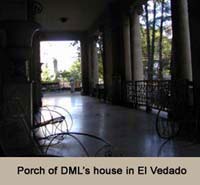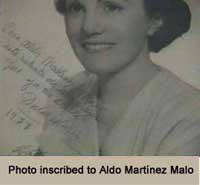

| Page [1] [2] [3] [4] [5] |

The Communist revolution triumphed in 1959,. and Pablo Alvarez de Cañas soon left the country. Dulce María remained secluded in the home they had shared in the formerly-fashionable El Vedado district of Havana.
In a Havana interview with Judith Kerman, Miguel Barnet discussed Loynaz’s political position after the Revolution.

{Audio
Link: Barnet
- the political situation}
When asked why she did not emigrate, Dulce María explained simply
that she stayed in Cuba after the Revolution because “I was here
first.”
More than 10 years later, her husband Pablo returned, terminally ill; he died
in Cuba in 1974. In an interview with the Spanish newspaper Diario 16
at the time she received the Cervantes prize, Dulce María reflected,
"In my life I have shed so many tears for this man that I had none left
to pour into his tomb.."
Although she participated in a poetry festival organized by the Cuban
Writers’ Union in 1968, presented a few academic papers in the 70’s,
and was involved in the Cuban branch of the Royal Academy of Language,
chronologies of Dulce María’s life from the Revolution through
the early 1980's are mostly marked by the deaths of her husband, father,
and two brothers.
{Audio
Link: Barnet
- emergence in the 1980's}
Dulce María self-imposed seclusion was quite successful. As Pedro
Simón described it to me, her emergence around the time of her
nomination for the Cervantes prize was a great surprise to the public.
Unknown to almost everyone, she had been living there in Havana all along.
{Audio
Link: Simón
- the Cervantes nomination}
In the 1970’s, well before the cultural thaw of the 1980’s,
Dulce María received a letter from Aldo Martínez Malo, a
man she had never met who had been a fan of hers in his youth. Later,
much to the surprise and dismay of some Havana cultural leaders, Dulce
María’s art collection, archives and manuscripts were given
to a group of friends, including Malo, in the distant provincial capital
of Pinar del Río, where a foundation was established for the study
of the works of the four Loynaz sisters and brothers.

{Audio Link: Malo's friendship with Dulce María}